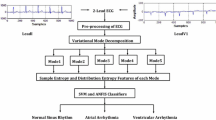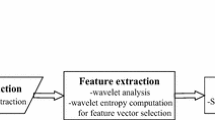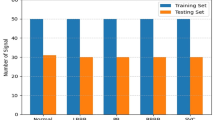Abstract
This study proposes feature extraction using Hilbert transforms, phase-space reconstruction, and time-domain analysis to detect ventricular fibrillation and normal sinus rhythm from electrocardiogram (ECG) episodes. We implemented three preprocessing steps to extract features from ECG episodes. In the first step, we use Hilbert transforms to extract peaks. In the second step, we use statistical methods and extract four features from the peaks. In the final step, we extract four features using statistical methods based on the Euclidean distance between the origin (0, 0) and the peaks after the peaks are plotted in a two-dimensional phase-space diagram. By applying time-domain analysis directly to the series of successive peak-to-peak interval values, we extract seven additional features. Using a neural network with weighted fuzzy membership functions (NEWFM), we applied the nonoverlap area distribution measurement method, and from 15 initial features, we selected 11 minimum features exhibiting the highest accuracy. Then, we applied the 11 minimum features as inputs to the NEWFM and recorded sensitivity, specificity, and accuracy values of 79.12, 89.58, and 87.51 %, respectively. In addition, McNemar’s test revealed a significant difference between the performances of NEWFM with and without feature selection (p < 0.05).









Similar content being viewed by others
References
Afonso VX, Tompkins WJ (1995) Detection ventricular fibrillation. IEEE Eng Med Biol Mag 14(2):152–159
Alexandre B, Laurent B, Alice C, Phillipe N, Lionel L, Daniela GT, Vjekoslav L, Céline M, Guillaume C (2009) Multimodal focus attention and stress detection and feedback in an augmented driver simulator. Pers Ubiquit Comput 13:33–41
Amann A, Tratnig R, Unterkofler K (2007) Detecting ventricular fibrillation by time-delay methods. IEEE Trans Biomed Eng 54(1):174–177
Arzeno NM, Deng Z-D, Poon C-S (2008) Analysis of first-derivative based QRS detection algorithms. IEEE Trans Biomed Eng 55(2):478–484
Baek SJ, Han JS, Chung KY (2013) Dynamic reconfiguration based on goal-scenario by adaptation strategy. Wireless Pers Commun. doi:10.1007/s11277-013-1239-0
Barro S, Ruiz R, Cabello D, Mira J (1989) Algorithmic sequential decision-making in the frequency domain for life threatening ventricular arrhythmias and imitative artifacts: a diagnostic system. J Biomed Eng 11:320–328
Burcu C, Bert A, Roberto LM, Gerhard T (2013) Monitoring of mental workload levels during an everyday life office-work scenario. Pers Ubiquit Comput 17:229–239
Choi S, Jiang Z (2008) Comparison of envelope extraction algorithms for cardiac sound signal segmentation. Expert Syst Appl 34:1056–1069
Chuang L-Y, Tsai S-W, Yang C-H (2011) Improved binary particle swarm optimization using catfish effect for feature selection. Expert Syst Appl 38:12699–12707
de Cristina N, Michael B, Carlo M, del José RM (2011) Brain-computer interfaces for space applications. Pers Ubiquit Comput 15:527–537
Dornaika F, Lazkano E, Sierra B (2011) Improving dynamic facial expression recognition with feature subset selection. Pattern Recogn Lett 32:740–748
Engin M (2004) ECG beat classification using neuro-fuzzy network. Pattern Recogn Lett 25:1715–1722
Gunn SR (1998) Support vector machines for classification and regression, faculty of engineering and applied science, technical report, pp 1–54
Hahn SL (1996) Hilbert transforms in signal processing. Artech House Publishers
Han JS, Chung KY, Kim GJ (2013) Policy on literature content based on software as service. Multimed Tools Appl. doi:10.1007/s11042-013-1664-9
Kabir M, Islam M, Murase K (2010) A new wrapper feature selection approach using neural network. Neurocomputing 73:3273–3283
Kandaswamy A, Sathish KC, Ramanathan RP, Jayaraman S, Malmurugan N (2004) Neural classification of lung sounds using wavelet coefficients. Comput Biol Med 34:523–537
Karayiannis N (2000) Soft learning vector quantization and clustering algorithms based on ordered weighted aggregation operators. IEEE Trans Neural Netw 11:1093–1105
Kim SH, Chung KY (2013) Medical information service system based on human 3D anatomical model. Multimed Tools Appl. doi:10.1007/s11042-013-1584-8
Kim JH, Chung KY (2013) Ontology-based healthcare context information model to implement ubiquitous environment. Multimed Tools Appl. doi:10.1007/s11042-011-0919-6
Ko JW, Chung KY, Han JS (2013) Model transformation verification using similarity and graph comparison algorithm. Multimed Tools Appl. doi:10.1007/s11042-013-1581-y
Kong DR, Xie HB (2011) Use of modified sample entropy measurement to classify ventricular tachycardia and fibrillation. Measurement 44:653–662
Lee S-H, Lim JS (2011) Forecasting KOSPI based on a neural network with weighted fuzzy membership functions. Expert Syst Appl 38:4259–4263
Lee S-H, Lim JS (2012) Parkinson’s disease classification using gait characteristics and wavelet-based feature extraction. Expert Syst Appl 39:7338–7344
Lee S-H, Lim JS (2013) Comparison of DBS and levodopa on resting tremor using a fuzzy neural network system. Measurement 46:1995–2002
Lim JS (2009) Finding features for real-time premature ventricular contraction detection using a fuzzy neural network system. IEEE Trans Neural Netw 20:522–527
Linh TH, Osowski S, Stodolski M (2003) On-line heart beat recognition using Hermite polynomials and neuro-fuzzy network. IEEE Trans Instrum Meas 52(4):1224–1231
Martínez Sotoca JM, Pla F (2010) Supervised feature selection by clustering using conditional mutual information-based distances. Pattern Recogn 43:2068–2081
Mateo J, Laguna P (2000) Improved heart rate variability signal analysis from the beat occurrence times according to the IPFM model. IEEE Trans Biomed Eng 47(8):985–996
McNemar Q (1947) Note on the sampling error of the difference between correlated proportions or percentages. Psychometrika 12:153–157
Merigó JM, Casanovas M (2011) Induced aggregation operators in the Euclidean distance and its application in financial decision making. Expert Syst Appl 38:7603–7608
Minami K, Nakajima H, Toyoshima T (1999) Real-time discrimination of ventricular tachyarrhythmia with Fourier-transform neural network. IEEE Trans Biomed Eng 46(2):176–185
Nikolopoulos S, Alexandridi A, Nikolakeas S, Manisc G (2003) Experimental analysis of heart rate variability of long-recording electrocardiograms in normal subjects and patients with coronary artery disease and normal left ventricular function. J Biomed Inform 36:202–217
Nygards M, Sörnmo L (1983) Delineation of the QRS complex using the envelope of the ECG. Med Biol Eng Comput 21:538–547
Oiws MI, Abou-Zied AH, Youssef AM (2002) Study of features based on nonlinear dynamical modeling in ECG arrhythmia detection and classification. IEEE Trans Biomed Eng 29(7):733–736
Osowski S, Linh TH (2001) ECG beat recognition using fuzzy hybrid neural network. IEEE Trans Biomed Eng 48(4):1265–1271
Packard NH, Crutchfield JP, Farmer JD, Shaw RS (1980) Geometry from a time series. Phys Rev Lett 45:712–716
Schölkopf B, Smola AJ, Williamson RC, Bartlett PL (2000) New support vector algorithms. Neural Comput 12:1207–1245
Shyu L-Y, Wu Y-H, Hu W (2004) Using wavelet transform and fuzzy neural network for VPC detection from the Holter ECG. IEEE Trans Biomed Eng 51(7):1269–1273
Sivakumar B (2002) A phase-space reconstruction approach to prediction of suspended sediment concentration in rivers. J Hydrol 258:149–162
Sivakumar B, Jayawardena AW, Fernando TMKG (2002) River flow forecasting: use of phase-space reconstruction and artificial neural networks approaches. J Hydrol 265:225–245
Small M, Yu D, Harrison RG, Robertson C, Clegg G, Holzer M (2000) Deterministic nonlinearity in ventricular fibrillation. Chaos 10:268–277
Su Z-G, Wang P-H (2012) Minimizing neighborhood evidential decision error for feature evaluation and selection based on evidence theory. Expert Syst Appl 39:527–540
Subasi A (2007) EEG signal classification using wavelet feature extraction and a mixture of expert model. Expert Syst Appl 32:1084–1093
Szmidt E, Kacprzyk J (2000) Distances between intuitionistic fuzzy sets. Fuzzy Sets Syst 114:505–518
Tanaka K, Hargens AR (2004) Wavelet packet transform for R–R interval variability. Med Eng Phys 26:313–319
Übeyli ED (2009) Adaptive neuro-fuzzy inference system for classification of ECG signals using Lyapunov exponents. Comput Methods Programs Biomed 93(3):313–321
Übeyli ED (2010) Recurrent neural networks employing Lyapunov exponents for analysis of ECG signals. Expert Syst Appl 37:1192–1199
van den Broek EL (2013) Ubiquitous emotion-aware computing. Pers Ubiquit Comput 17:53–67
Xie HB, Gao ZM, Liu H (2011) Classification of ventricular tachycardia and fibrillation using fuzzy similarity-based approximate entropy. Expert Syst Appl 38:3973–3981
Acknowledgments
This research was supported by Basic Science Research Program through the National Research Foundation of Korea (NRF) funded by the Ministry of Education, Science and Technology (NRF-2012R1A1A2044134). This research was supported by MSIP (the Ministry of Science, ICT and Future Planning), Korea, under the IT-CRSP (IT Convergence Research Support Program) (NIPA-2013-H0401-13-1001) supervised by the NIPA (National IT Industry Promotion Agency).
Author information
Authors and Affiliations
Corresponding author
Rights and permissions
About this article
Cite this article
Lee, SH., Chung, KY. & Lim, J.S. Detection of ventricular fibrillation using Hilbert transforms, phase-space reconstruction, and time-domain analysis. Pers Ubiquit Comput 18, 1315–1324 (2014). https://doi.org/10.1007/s00779-013-0735-2
Received:
Accepted:
Published:
Issue Date:
DOI: https://doi.org/10.1007/s00779-013-0735-2




